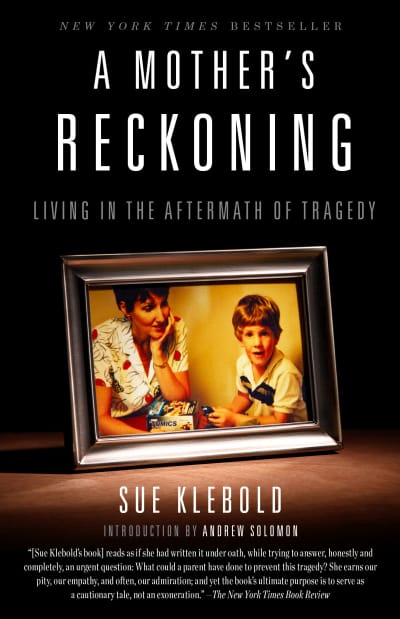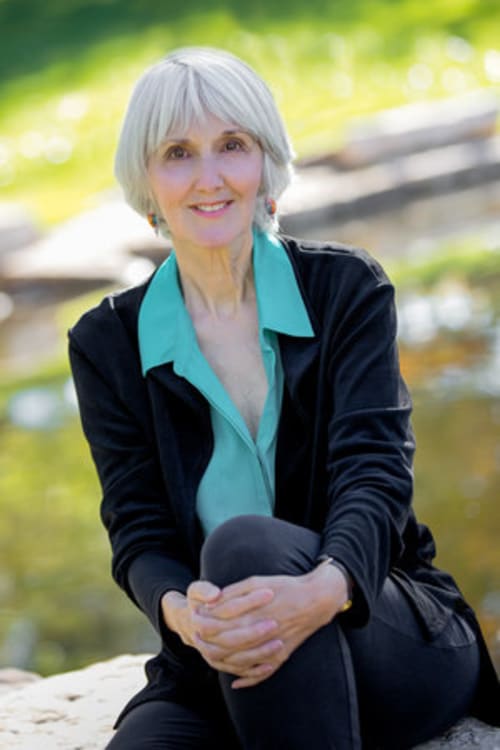A Mother’s Reckoning

On April 20, 1999, Eric Harris and Dylan Klebold walked into Columbine High School in Littleton, Colorado. Over the course of minutes, they would kill twelve students and a teacher and wound twenty-four others before taking their own lives.
Ever since, Sue Klebold, Dylan’s mother, has lived with the indescribable grief and shame of that day. How could her child, the promising young man she had loved and raised, be responsible for such horror? And how, as his mother, had she not known something was wrong? In the hope that the insights and understanding she has gained may help other families recognize when a child is in distress, she tells her story in full, drawing upon her personal journals, the videos and writings that Dylan left behind, and on countless interviews with mental health experts.
Filled with hard-won wisdom and compassion, A Mother’s Reckoning is a powerful and haunting book that sheds light on one of the most pressing issues of our time.
Reviews
“As people read Sue’s memoir, what they will find is that her book is honest, and her pain genuine. Her story may be uncomfortable to read, but it will raise awareness about brain health and the importance of early identification and intervention to maintain it. If people listen to her – to all that she has experienced, and to how this has changed her – they will be quicker to respond to depression in young people, to the suicidal thinking that can accompany it, and to the rage that can build almost unnoticed in young people when the people who truly and completely love and care for them are distracted by other challenges in life.” —Paul Gionfriddo, President and CEO of Mental Health America
“Reading this book as a critic is hard; reading it as a parent is devastating….I imagine snippets of my own young children in Dylan Klebold, shades of my parenting in Sue and Tom. I suspect that many families will find their own parallels….This book’s insights are painful and necessary and its contradictions inevitable.” —The Washington Post
“[Sue Klebold’s book] reads as if she had written it under oath, while trying to answer, honestly and completely, an urgent question: What could a parent have done to prevent this tragedy?… Eventually, Klebold found her way forward with a mission of suicide prevention, and she provides a precise education on the subject in “A Mother’s Reckoning.” She earns our pity, our empathy and, often, our admiration; and yet the book’s ultimate purpose is to serve as a cautionary tale, not an exoneration.” —The New York Times Book Review
“Here is the parenting book everyone should read.” —Parents.com
“I believe Sue Klebold. So will you.” —LA Times
“At times her story is so chilling you want to turn away, but Klebold’s compassion and honesty –and realization that parents and institutions must work to discover kids’ hidden suffering-will keep you riveted.” —People.com
“This book which can be tough to read in places is an important one. It helps us arrive at a new understanding of how Columbine happened and, in the process, may help avert other tragedies.” Rated: A. —Entertainment Weekly
“A powerful book every parent needs to read.” —Momzinga.com
“This is the most harrowing book I have read and should be required reading for the parents of adolescents….a book of nobility and importance.” —The Times (UK)
“Immensely powerful read that moves from a thriller-like retelling to a polemic on our ignorance about mental illness.” —Sunday Times Culture
“As harrowing as it is engrossing… For those of us who are also parents of teenagers… it would be somehow reassuring to know that there was a dysfunctional family or that there indeed were neon danger signs. It wasn’t and there weren’t. That’s what makes it such a scary book to read. The Klebolds were a family rather like mine, and maybe yours, too.” —Daily Mail Book of the Week
A Note from Sue Klebold
My son was Dylan Klebold, one of the two shooters at Columbine High School in 1999.
I would gladly have given my life to reverse what happened that day and yet I know that nothing I can do or say could ever atone for Dylan’s choices, choices that I have spent decades trying to understand. I wish I had known then what I know now: that it was possible for everything to seem fine with him when it was not, and that behaviors I mistook as normal for a moody teenager might have been subtle signs of psychological deterioration.
Although it is very hard for me to share my story—to lay bare my heart and the inner workings of my family—I feel a moral imperative to share the insights I have gleaned to help other families see the signs when their children need help.
Today I am an advocate for mental health awareness, research and suicide prevention. By writing A Mother’s Reckoning, I hoped to shine a light on these important issues. Through my Colorado public benefit corporation (PBC), Vention Resources, Inc., PBC, all author profits received from the publication of this book, after reasonable expenses, have been used to fund charitable organizations that share my goals and strive to address these concerns, including Mental Health America (MHA), National Alliance on Mental Illness (NAMI), American Foundation for Suicide Prevention (AFSP), American Association of Suicidology (AAS) and the Brain & Behavior Research Foundation.
—SUE KLEBOLD
About Sue Klebold

Photo: © J-K Photography
Sue Klebold is the mother of Dylan Klebold, one of the two shooters at Columbine High School—a tragedy that saddened and galvanized the nation. Prior to publishing A Mother’s Reckoning, Sue spent 15 years after the tragedy excavating every detail of her family life, and trying to understand the crucial intersection between mental health problems and violence. Instead of becoming paralyzed by her grief and remorse, she became a passionate and effective agent working to advance mental health awareness and intervention. She participated in presentations, co-chaired conferences at the state and national levels, volunteered on local non-profit boards for suicide prevention organizations, and wrote about the experience of surviving a loved one’s murder-suicide. Sue is a member of the National Loss and Healing Council of the American Foundation for Suicide Prevention (AFSP), and is a member of the National Suicide Prevention Lifeline Lived Experience Subcommittee. Sue is currently not available on Facebook, Twitter or any other social media platform.
For speaking engagements, please contact:
Tom Neilssen, BrightSight Group www.brightsightspeakers.com
tom@brightsightgroup.com | 609-924-3060, x16
Resources
There are so many excellent resources out there that this list could easily be a thousand pages long. I’ve winnowed it down to the resources I recommend the most.
Suicide Prevention
National Suicide Prevention Lifeline 1–800–273-TALK (8255) www.suicidepreventionlifeline.org
If you or someone you love is in crisis (with or without thoughts of imminent suicide), call the National Suicide Prevention Lifeline for help.Your call will be automatically routed to a trained crisis worker who will listen and can tell you about mental health services in your area. The service is free and confidential, and the line is open 24/7. Everyone should keep this number handy.
The American Foundation for Suicide Prevention www.afsp.org
Suicide Prevention Resource Center www.sprc.org
American Association of Suicidology www.suicidology.org
The Jed Foundation (For college students and their families) www.jedfoundation.org
These organizations provide amazing resources on a variety of topics, including how to recognize the warning signs of suicide and who’s at risk, what you can do to help the bereaved survivors of suicide loss, how to talk to children about suicide deaths in the family, and much more. Invaluable for survivors, educators, activists, and people at risk, as well as anyone concerned about this issue.
Mental Health First Aid (for Youth and Adults)
Mental Health First Aid www.mentalhealthfirstaid.org
Mental Health First Aid, a national organization, offers hands-on training to help people recognize the signs of addiction and mental health distress. I’ve taken the course three times and think everyone should. It’s very powerful to know that for the price of one Saturday, you could save a life.
ULifeline (For college students and their families) www.ulifeline.org
LGBT and Transgender
Half of Us www.halfofus.com
The Trevor Project www.thetrevorproject.org
Bullying
Stop Bullying www.stopbullying.gov
Bullying can be a problem with any age group; parents and schools can help.
Peer Resources
Kids are more likely to talk to their friends than to an adult, so kids have to know what to do if a friend is struggling with suicidal thoughts. The “Save a Friend” tip sheet from the National Association of School Psychologists is a brief introduction to what every one of them should know. (Notice the importance of having access to a responsible adult or a crisis team member who has been trained to respond appropriately.)
Save a Friend: Tips for Teens to Prevent Suicide
www.nasponline.org/resources-and-publications/resources-and-podcasts
School Response to Suicide
In the aftermath of suicide, the safety of other students can depend on how a school handles the tragedy. This booklet (created by the American Foundation for Suicide Prevention and the Suicide Prevention Resource Center) provides a practical road map for a difficult time. Aside from the Lifeline, I recommend this resource more often than any other.
After a Suicide: A Toolkit for Schools www.sprc.org/library_resources/items/after-suicide-toolkit-schools
Violence Prevention
Center for Disease Control – Division of Violence Prevention www.cdc.gov/violenceprevention/nvdrs
The Centers for Disease Control’s Division of Violence Prevention does important work. In particular, I would like to highlight the National Violent Death Reporting System, an invaluable tool in violence prevention. This database offers comprehensive, anonymous reporting on violent deaths. Linking information about the “who, what, when, where, and how” from data on violent deaths helps us to understand why they happened. Over time, the database can show whether various efforts to prevent violence are working. Currently, only thirty-two states have the funding to participate.
Gun Safety
No matter where you stand on gun control and gun ownership, there is an undisputed relationship between access to firearms and increased suicide risk.
The Means Matter – Harvard School of Public Health
www.hsph.harvard.edu/means-matter/means-matter
The Means Matter program from the Harvard School of Public Health features informative and unique approaches to promoting gun safety for all. One of its initiatives, the New Hampshire Gun Shop Project, is a model for collaborative prevention without conflict.
Media Guidelines
How the media reports on incidents involving suicide can affect public health and safety in the aftermath of tragedy. I would like to see a similar protocol developed for reporting on murder-suicide. Everything we do to increase knowledge, inhibit myth-making, and minimize trauma makes our communities safer. These are some guidelines:
www.theactionalliance.org/messaging/entertainment-messaging/national-recommendations
www.reportingonmassshootings.org
Threat Assessment curry.virginia.edu/research/projects/threat-assessment
The Virginia Student Threat Assessment Guidelines provide schools with safe, structured, and efficient ways to respond to student threats of violence. This is a model for threat assessment that emphasizes early attention to problems such as bullying, teasing, and other forms of student conflict before they escalate into violent behavior. Now used in more than three thousand schools in eighteen states, this program trains multidisciplinary teams in a single day. Threat assessment programs don’t simply reduce student violence. They can help teachers and staff identify kids at risk of many kinds of harm, including suicide, partner violence, and child abuse.
Stay in Touch
By clicking Sign Up, I acknowledge that I have read and agree to Penguin Random House's Privacy Policy and Terms of Use and understand that Penguin Random House collects certain categories of personal information for the purposes listed in that policy, discloses, sells, or shares certain personal information and retains personal information in accordance with the policy. You can opt-out of the sale or sharing of personal information anytime.
